03 Aug 08/03/2020
An Overview of Latex Allergy Gloves
Many jobs across the U.S., especially in the manufacturing and construction industries, require workers to wear gloves that protect their hands, wrists, and arms from workplace hazards. According to the Bureau of Labor Statistics (BLS), manufacturing ranks #1 for hand injuries, with 26,440 hand injuries occurring in 2018. Construction ranks #2 on the list with 13,930 hand injuries. These stats are vital because they highlight the workers who need hand protection the most and are likely to wear gloves every day.
It would be nice if wearing gloves was comfortable and safe for everyone. As you know, life is not so simple and especially not straightforward when it comes to protecting workers from injury. One example of an often-overlooked concern is a worker who finds themselves allergic to latex and must search for alternative forms of hand protection to keep them safe. The gloves other workers are wearing might not be best for you. Why is this the case?

Milky sap drips from a rubber tree.
Some people are sensitive to the latex protein that's contained in natural rubber, which comes from the milky sap of the Hevea brasiliensis, or rubber tree. As a result of this sensitivity, rubber latex gloves—and the powder in latex gloves—can cause an allergic reaction in people with hypersensitivity to this latex protein. Although the reason for the allergic reaction is unknown, repeated skin exposure to latex products may increase a person's sensitivity to latex. That's why people who continually wear gloves, like those who work in manufacturing, construction, tire manufacturing, and healthcare, are more susceptible to latex allergies.
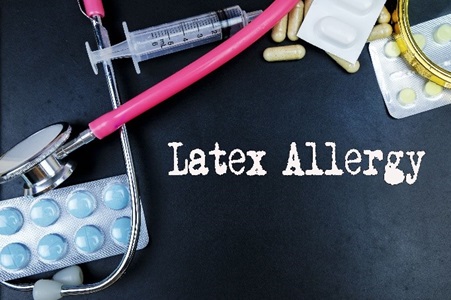
Don't worry – there are latex-free options available. At MCR Safety, we've been manufacturing gloves for years, and we have a wide range of latex-free options available. We will highlight those gloves and much more below.
Allergy Types

Numerous allergens can trigger severe reactions in humans. With upwards of 45 million Americans impacted by allergies, you know that means there isn't just one allergen causing all the problems. Here is a quick snapshot of the most common allergens:
- animal dander
- dust mites
- foods and medications
- insect stings
- pollen
- mold
- and, yes, latex
Interestingly, people with known food allergies to apples, bananas, carrots, celery, chestnuts, kiwi, melons, papayas, raw potatoes, avocadoes, pineapple, and tomatoes are more likely to have a latex allergy, too. This is because these foods can also react with the latex protein and cause symptoms in people.
For additional details on the allergies mentioned above, we recommend visiting WebMD's allergy triggers reference page. From here on, we will only be highlighting latex allergies, since it is the allergy that impacts people wearing PPE the most.
*Disclaimer* - if you suspect you may have an allergy, it is best to seek medical advice from a licensed medical professional.
Latex Glove Allergy Symptoms
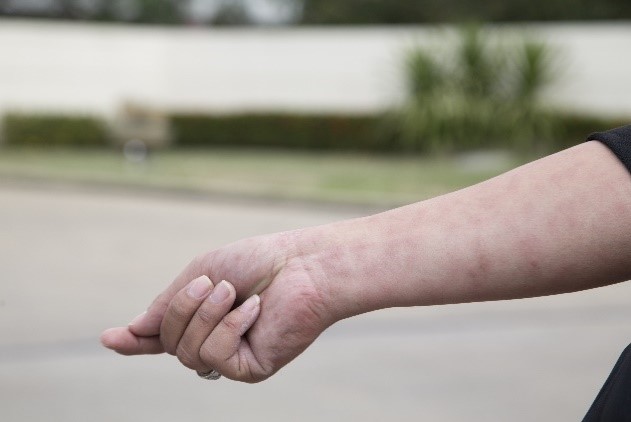
Reactive symptoms of an allergy to latex range in severity from mild to life-threatening and depend on your sensitivity to the latex protein and the exposure amount. Your reaction can become worse with each additional latex exposure. Here are some of the symptoms to be looking for:
Mild Symptoms
Itching
Skin redness
Hives or rash
Severe Symptoms
Sneezing
Runny nose
Itchy, watery eyes
Scratchy throat
Difficulty breathing
Wheezing
Cough
Life-Threatening Symptoms
Anaphylaxis
If you have trouble breathing, nausea and vomiting, dizziness, a drop in blood pressure, confusion or loss of consciousness, a rapid or weak pulse, hives, or swelling after exposure to latex, seek emergency medical care immediately.
The Rash
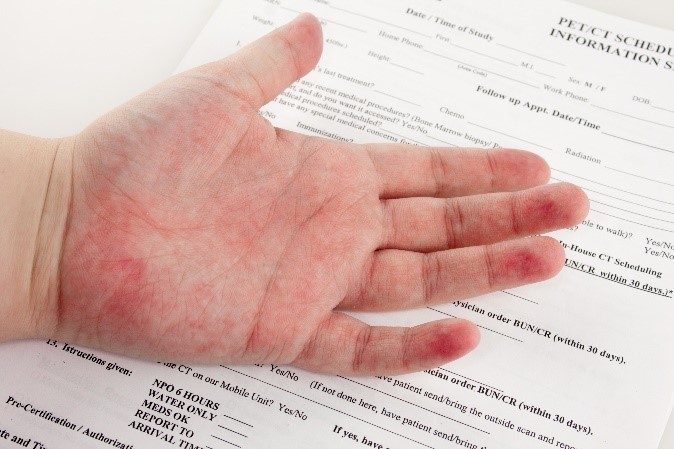
Because of the symptoms noted above, you will likely know when you're experiencing an allergic reaction to latex, and the signs will be almost immediate. After contact with latex in the form of, for example, a latex glove, the skin at the place of contact with the latex will appear swollen and tight and could be flushed or red, itchy or tingling. You may also experience a breakout of hives. An allergic reaction to latex may also manifest with symptoms similar to hay fever, like sneezing, runny nose, or itchy eyes.
Testing
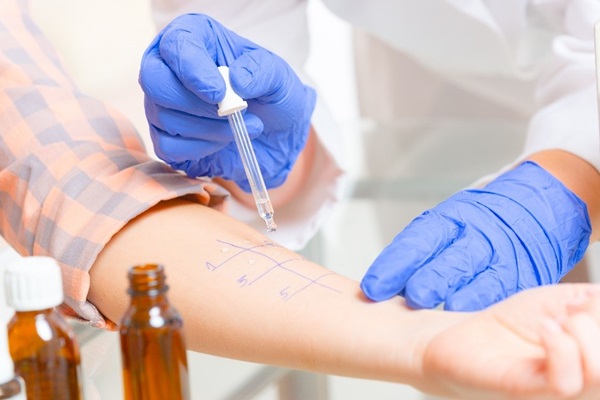
For anyone who has experienced the above symptoms, be sure to see your doctor and ask to take a latex allergy test. Doctors can find out if you're allergic to latex with a few different tests:
- Skin Testing - The percutaneous (prick) test and radioallergosorbent (RAST) test identify the latex-specific IgE antibody and are convenient, sensitive, and fast ways to test for a latex allergy.
- Vitro Serologic Testing - The Immuno-CAP, AlaSTAT FEIA, and HYTEC-EIA are FDA-approved diagnostic tests to measure sensitivity and specificity to the latex-specific IgE antibody.
- Vivo Provocation Testing - If a person's medical history and latex skin test or serologic test don't match, allergists perform this latex glove use test. A latex glove is worn for 10 to 15 minutes, and any symptoms are noted.
For people who report allergic symptoms with fruits and vegetables that can cross-react with latex proteins, identification of the food-specific IgE can be made by the skin prick test or RAST.
Treatment
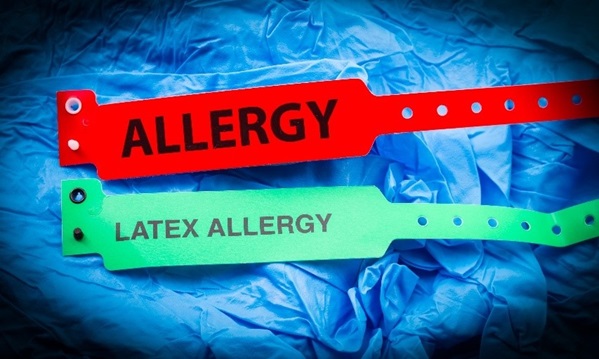
Since no cure for a latex allergy exists, the best thing to do is reduce the risk of exposure. Maybe better put, avoiding a latex glove allergy means being prepared with PPE that doesn't cause the reaction in the first place. People who have a latex allergy and who must wear gloves in the workplace may use non-latex gloves made with vinyl, nitrile, or other compounds that contain no latex proteins. They may also opt to wear powder-free gloves, hypoallergenic gloves, or insert glove liners to protect their hands. In the case of a severe allergic reaction to latex, workers may wear a medical ID bracelet that details their allergy.
For mild reactions, doctors may prescribe antihistamines to help combat the reaction. Injectable epinephrine can be used to prevent anaphylaxis in severe allergic reactions. As always, an ounce of prevention is worth a pound of cure. Our next section will highlight prevention.
*Disclaimer* - A doctor should only prescribe medication. The above information is only for informational purposes and not medical advice.
Latex-Free Gloves for Construction and Manufacturing
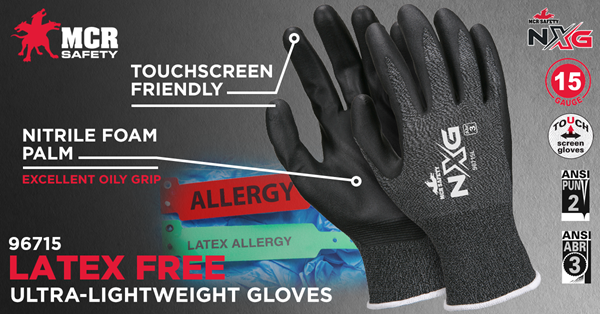
As we mentioned earlier, MCR Safety offers a wide variety of latex-free gloves. We have made it simple to locate them, too.
In our online glove catalog, we've created a filter that quickly tells you which gloves are latex-free. We've made it even simpler if you're reading this article: simply click here. Below are three of our newest latex-free glove options:
96695 / Polyurethane dipped

96715 / Black Nitrile dipped
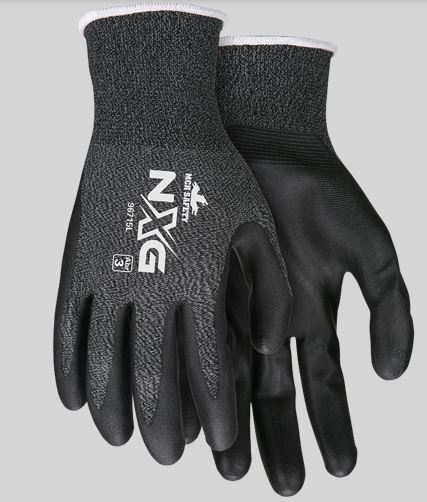
967315 / Gray Nitrile dipped

If your job requires you to wear disposable gloves, our disposable nitrile gloves are an excellent alternative to traditional disposable latex gloves.
We called this section Latex-Free Gloves for Construction and Manufacturing because those are the two industries that most often request these gloves. The three glove types we highlight above are ideal for both sectors due to the abrasive nitrile coating and the thin shells that allow for excellent hand movement. Plus, our NXG lineup of gloves is made with advanced polymer coatings and proprietary shell-drying techniques and are all made in eco-friendly factories. And even if you're not in the construction or manufacturing industry, these gloves can be used across any industry.
Common Questions

How long do latex allergy symptoms last?
- If you are allergic to latex, it is a sensitivity that will last for the rest of your life. Contact dermatitis symptoms can start 12 to 14 hours after initial or repeated contact with latex. However, an allergic reaction may not appear until one to four days after contact—both cause dry, itchy, burning skin in different degrees of severity. If you have an immediate allergic reaction to latex, such as trouble breathing, cramps, hives, low blood pressure, or anaphylaxis, call 911 immediately.
How common is latex allergy?
- Less than 1 percent of people in the U.S. have a latex allergy, according to the Asthma and Allergy Foundation of America (AAFA). New latex allergy cases are less common these days since non-latex gloves have been developed and are widely available for people who need to use gloves at their workplace.
Can you develop a latex allergy?
- Latex allergies can develop after repeated exposure to latex, especially for those who regularly wear latex gloves on the job, including construction workers, people who work in the rubber or manufacturing industries, and healthcare workers.
What protein causes latex allergy?
- Latex protein from natural rubber latex is the allergen that causes people with a latex allergy to have a reaction when it comes in contact with their skin. For example, some people may react when blowing up a rubber balloon or breathing in powder from the inside of latex gloves.
Who is at risk for a latex allergy?
- Construction workers, manufacturing workers, healthcare workers, dentists, vets, workers in the rubber industry and food preparation industry, beauticians, and gardeners are most commonly exposed to latex and are most likely to develop a latex allergy.
Which is the most serious type of latex allergy?
- The type I, or IgE-mediated latex allergy is a true allergy to natural rubber latex proteins. The body's immune system makes antibodies called immunoglobulin E (IgE) antibodies that react with latex proteins and cause allergy symptoms that can be severe and life-threatening.
Protecting All Workers

Our gloves protect people from workplace hazards, including cuts, punctures, tears, abrasions, heat, and cold. If you must avoid wearing latex gloves due to an allergy, we've got you covered, utilizing the latest technologies to bring you the safest gear.
Click the image above to request a quote, leave us a comment, ask a question, or share any concerns.
For over 45 years, MCR Safety has proven to be a world leader in gloves, glasses, and garments. Whether it's on the shop floor, an oil rig, or a construction site, we are there to provide solutions to workplace hazards. It's all part of our commitment to protect people.
No matter your industry, we have the personal protective equipment you need.

Learn more about MCR Safety by checking out our most recent video. For more information, browse our website, request a catalog, find a distributor, or give us a call at (800) 955-6887.
About the Author
Related Articles
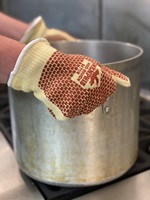
Our Top 10 Best Oven Gloves
When it comes to heat-resistant PPE, MCR Safety has an incredible selection of gloves to help...
Hand Size Measuring Solutions and Glove Size Chart |
If you are unsure about your hand size, you'll need to perform some calculations to determine...Latest Articles






